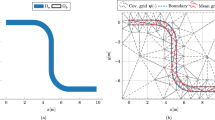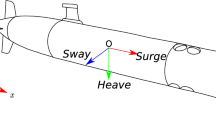Abstract
Autonomous underwater vehicles (AUVs) are advancing the state of the art in numerous scientific and commercial applications. The current surge in micro electronics enables the development of small micro AUVs (\(\mu \)AUVs) which are expected to gain increasing popularity in industrial applications such as monitoring of liquid-based processes. This paper presents an information theoretic approach for exploration and monitoring of liquid containing tanks with \(\mu \)AUVs. The controller is based on ideas from path integral control and inference with Gaussian Markov random fields (GMRFs). Both parts are combined in a receding horizon scheme to the PI-GMRF controller. The control problem is formulated within the stochastic optimal control domain and a solution is stated as a path integral. In order to close the control theoretic loop each \(\mu \)AUV maintains a belief representation of the environment expressed with GMRFs which allows reasoning by computing posterior distributions conditioned on measurements. Each \(\mu \)AUV has its own controller instance and the system is decentral. Only the exchange of measurements and intended control inputs of each \(\mu \)AUV is required through the communication link. The approach is validated in simulations for an advection–diffusion scenario and benchmarked against random walk, which it outperforms.















Similar content being viewed by others
References
Bourgault, F., Makarenko, A. A., Williams, S. B., Grocholsky, B., & Durrant-Whyte, H. (2002). Information based adaptive robotic exploration. In IEEE/RSJ international conference on intelligent robots and systems (IROS) (pp. 540–545). Lausanne.
Csató, L., & Opper, M. (2002). Sparse on-line Gaussian processes. Neural Computation, 14(3), 641–668.
Cui, R., Li, Y., & Yan, W. (2016). Mutual information-based multi-AUV path planning for scalar field sampling using multidimensional RRT. IEEE Transactions on Systems, Man, and Cybernetics: Systems, 46(7), 993–1004.
Devries, L., Majumdar, S. J., & Paley, D. A. (2013). Observability-based optimization of coordinated sampling trajectories for recursive estimation of a strong, spatially varying flowfield. Journal of Intelligent and Robotic Systems: Theory and Applications, 70(1–4), 527–544.
Duecker, D. A., Geist, A., Hengeler, M., Kreuzer, E., Pick, M. A., Rausch, V., et al. (2017). Embedded spherical localization system for micro underwater vehicles based on attenuation of electro-magnetic Carrier signals. Sensors, 17, 959–981.
Fiorelli, E., Leonard, N. E., Bhatta, P., Paley, D. A., Bachmayer, R., & Fratantoni, D. M. (2006). Multi-AUV control and adaptive sampling in Monterey Bay. IEEE Journal of Oceanic Engineering, 31(4), 935–948.
Geist, R. A., Hackbarth, A., Kreuzer, E., Rausch, V., Sankur, M., & Solowjow, E. (2016). Towards a hyperbolic acoustic one-way localization system for underwater swarm robotics. IEEE international conference on robotics and automation (ICRA) (pp. 4551–4556). Stockholm.
Gershman, S. J., Horvitz, E. J., & Tenenbaum, J. B. (2015). Computational rationality: A converging paradigm for intelligence in brains, minds, and machines. Science, 349(6245), 273–278.
Gómez, V., Thijssen, S., Symington, A., Hailes, S., & Kappen, H. J. (2015). Real-time stochastic optimal control for multi-agent quadrotor swarms. Preprint. arXiv:1502.04548.
Graham, R., & Cortés, J. (2012). Adaptive information collection by robotic sensor networks for spatial estimation. IEEE Transactions on Automatic Control, 57(6), 1404–1419.
Griffiths, A., Dikarev, A., Green, P. R., Lennox, B., Poteau, X., & Watson, S. (2016). AVEXIS-aqua vehicle explorer for in-situ sensing. IEEE Robotics and Automation Letters, 1(1), 282–287.
Hackbarth, A., Gray, A., & Kreuzer, E. (2012). Multi-agent motion control of autonomous vehicles in 3D flow fields. Proceedings in Applied Mathematics and Mechanics, 12(1), 733–734.
Hackbarth, A., Kreuzer, E., & Solowjow, E. (2015). Hippocampus: A micro underwater vehicle for swarm applications. In IEEE/RSJ international conference on intelligent robots and systems (IROS) (pp. 2258–2263). Hamburg.
Hollinger, G. A., & Sukhatme, G. S. (2014). Sampling-based robotic information gathering algorithms. The International Journal of Robotics Research, 33(9), 1271–1287.
Jonsson, J., Sundqvist, J., Nguyen, H., Kratz, H., Berglund, M., Ogden, S., et al. (2011). Miniaturized submersible for exploration of small aqueous environments. In MTS/IEEE OCEANS (pp. 1–8). Kona, HI.
Kappen, H. J. (2007). An introduction to stochastic control theory, path integrals and reinforcement learning. Cooperative Behavior in Neural Systems, 887, 149–181.
Krause, A. (2007). Nonmyopic observation selection: Theory and applications. PhD thesis. Pittsburgh, PA: Carnegie Mellon University.
Krige, D. G. (1951). A statistical approach to some basic mine valuation problems on the Witwatersrand. Journal of Chemical, Metallurgical, and Mining Society of South Africa, 52, 201–215.
LaValle, S. M., & Kuffner, J. J. (2001). Randomized kinodynamic planning. The International Journal of Robotics Research, 20(5), 378–400.
Le Ny, J., & Pappas, G. J. (2013). Adaptive deployment of mobile robotic networks. IEEE Transactions on Automatic Control, 58(3), 654–666.
Leonard, N. E., Paley, D. A., Lekien, F., Sepulchre, R., Fratantoni, D. M., & Davis, R. E. (2007). Collective motion, sensor networks, and ocean sampling. Proceedings of the IEEE, 95(1), 48–74.
Lindgren, F., Rue, H., & Lindström, J. (2011). An explicit link between Gaussian fields and Gaussian Markov random fields: The stochastic partial differential equation approach. Journal of the Royal Statistical Society: Series B, 73(4), 423–498.
Ma, K. C., Liu, L., & Sukhatme, G. S. (2016). Informative planning and online learning with sparse Gaussian processes. In IEEE/RSJ international conference on intelligent robots and systems (IROS) (pp. 2102–2108). Daejeon.
Marchant, R., & Ramos, F. (2014). Bayesian optimisation for informative continuous path planning. In IEEE international conference on robotics and automation (ICRA) (pp. 6136–6143). Hong Kong.
Marchant, R., Ramos, F., Sanner, S., et al. (2014). Sequential Bayesian optimisation for spatial–temporal monitoring. In Conference on uncertainty in artificial intelligence (UAI) (pp. 553–562). Quebec City, QC.
Marino, A., & Antonelli, G. (2015). Experiments on sampling/patrolling with two autonomous underwater vehicles. Robotics and Autonomous Systems, 67, 61–71.
Mintchev, S., Donati, E., Marrazza, S., & Stefanini, C. (2014). Mechatronic design of a miniature underwater robot for swarm operations. In IEEE international conference on robotics and automation (ICRA) (pp. 2938–2943). Hong Kong.
Myers, V., & Williams, D. P. (2010). A POMDP for multi-view target classification with an autonomous underwater vehicle. In MTS/IEEE OCEANS (pp. 1–5). Seattle, WA.
Paley, D. A., & Peterson, C. (2009). Stabilization of collective motion in a time-invariant flowfield. Journal of Guidance, Control, and Dynamics, 32(3), 771–779.
Pan, Y., Theodorou, E. A., & Kontitsis, M. (2014). Model-based path integral stochastic control: A Bayesian nonparametric approach. Preprint. arXiv:1412.3038.
Rue, H., & Held, L. (2005). Gaussian Markov random fields: Theory and applications. Boca Raton: CRC Press.
Ryan, A., & Hedrick, J. K. (2010). Particle filter based information-theoretic active sensing. Robotics and Autonomous Systems, 58(5), 574–584.
Simpson, D., Lindgren, F., & Rue, H. (2012). Think continuous: Markovian Gaussian models in spatial statistics. Spatial Statistics, 1, 16–29.
Stanković, M. S., & Stipanović, D. M. (2010). Extremum seeking under stochastic noise and applications to mobile sensors. Automatica, 46(8), 1243–1251.
Sydney, N., & Paley, D. A. (2014). Multivehicle coverage control for a nonstationary spatiotemporal field. Automatica, 50(5), 1381–1390.
Theodorou, E., Buchli, J., & Schaal, S. (2010a). A generalized path integral control approach to reinforcement learning. Journal of Machine Learning Research, 11(Nov), 3137–3181.
Theodorou, E., Buchli, J., & Schaal, S. (2010b). Reinforcement learning of motor skills in high dimensions: A path integral approach. In IEEE international conference on robotics and automation (ICRA) (pp. 2397–2403). Anchorage, AK.
Vasudevan, S., Ramos, F., Nettleton, E., & Durrant-Whyte, H. (2009). Gaussian process modeling of large-scale terrain. Journal of Field Robotics, 26(10), 812–840.
Williams, G., Drews, P., Goldfain, B., Rehg, J. M., & Theodorou, E. A. (2016). Aggressive driving with model predictive path integral control. In IEEE international conference on robotics and automation (ICRA) (pp. 1433–1440). Stockholm.
Xu, Y., Choi, J., Dass, S., & Maiti, T. (2013). Efficient Bayesian spatial prediction with mobile sensor networks using Gaussian Markov random fields. Automatica, 49(12), 3520–3530.
Xu, Y., Choi, J., Dass, S., & Maiti, T. (2015). Bayesian prediction and adaptive sampling algorithms for mobile sensor networks: Online environmental field reconstruction in space and time. Berlin: Springer.
Xu, Y., Choi, J., & Oh, S. (2011). Mobile sensor network navigation using Gaussian processes with truncated observations. IEEE Transactions on Robotics, 27(6), 1118–1131.
Zhang, B. Z. B., & Sukhatme, G. (2007). Adaptive sampling for estimating a scalar field using a robotic boat and a sensor network. In IEEE international conference on robotics and automation (ICRA). Roma.
Acknowledgements
This work was funded by the German Research Foundation (DFG) under Grant No. Kr 752/33-1. The support is greatly acknowledged.
Author information
Authors and Affiliations
Corresponding author
Additional information
This is one of the several papers published in Autonomous Robots comprising the Special Issue on Online Decision Making in Multi-Robot Coordination.
Rights and permissions
About this article
Cite this article
Kreuzer, E., Solowjow, E. Learning environmental fields with micro underwater vehicles: a path integral—Gaussian Markov random field approach. Auton Robot 42, 761–780 (2018). https://doi.org/10.1007/s10514-017-9685-2
Received:
Accepted:
Published:
Issue Date:
DOI: https://doi.org/10.1007/s10514-017-9685-2




